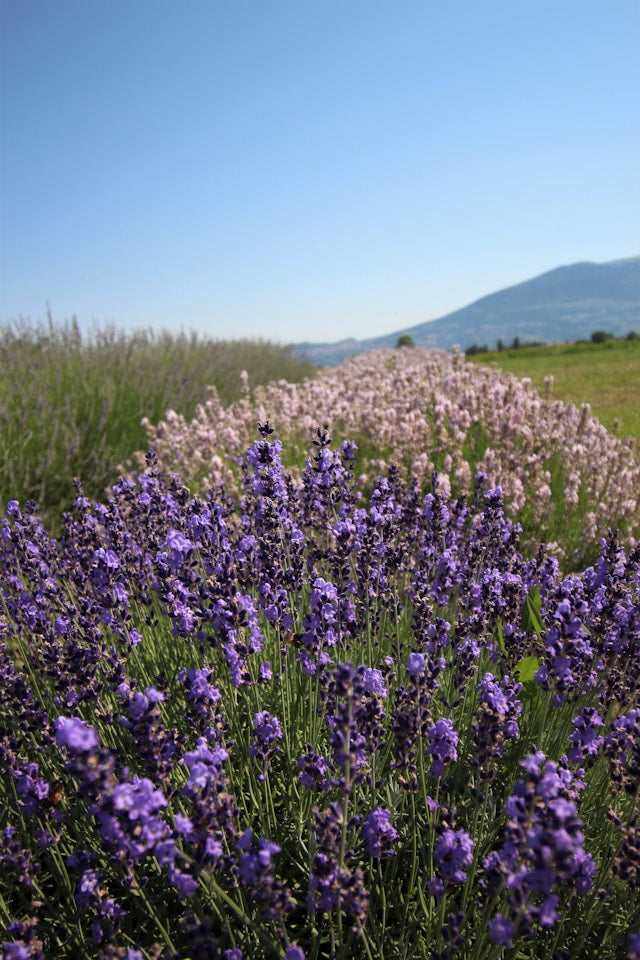
Lavender
Lavandula officinalis
Lavender is one of the most beloved plants in the world, known for its wonderful scent and versatile uses. This beautiful herb has been used for centuries for medicinal, cosmetic and culinary purposes.
In this blog we dive into the history, growing conditions, growing it yourself, the main ingredients and the interaction with the human body.
History of lavender
Lavender has a long and rich history dating back to the ancient civilizations of Egypt, Greece and Rome. In ancient Egypt, lavender oil was used in embalming and as a perfume. The Romans used lavender to perfume their bath water and as a medicinal herb.
In the Middle Ages, lavender was used as a protection against diseases such as the plague. Later, in the Renaissance and Victorian era, lavender became a symbol of purity and was widely used in perfumes and linen sprays. Today, lavender is praised worldwide for its wonderful scent and healing properties.

How & where does lavender grow?
Lavender is originally a Mediterranean plant and grows mainly in sunny, dry areas such as southern France, Spain and Italy. The plant thrives best in well-drained, chalky soil and can withstand dry conditions. Lavender can grow wild on hillsides and rocky areas, but is also grown commercially for the production of essential oils and cosmetic products.
Although lavender prefers warm climates, it can survive in colder areas as long as the soil is well-drained and it gets plenty of sunlight. The plant is hardy and can last for several years.
How to grow lavender at home?
Seeds or plants, buy or exchange
You can grow lavender from seed, but this process requires patience. A quicker option is to buy a young plant from a garden center or swap cuttings with other plant lovers. Taking cuttings from an existing plant is often more effective than sowing.
Choose the right location
Lavender loves full sun. Choose a spot where the plant gets at least 6 to 8 hours of sunlight per day. Avoid shady spots, as this will reduce the plant's growth and flowering.
Preparation
Lavender needs well-drained soil. If your soil is very clayey, mix in sand or gravel to improve drainage. A neutral to slightly alkaline pH (6.5 to 7.5) is ideal.
Maintenance
Water lavender moderately, especially during the first few months after planting. Once the plant is well-rooted, it needs little water.
Prune lavender in spring and after flowering to keep the plant compact and healthy. Do not over-fertilize; too much nitrogen can reduce flowering.
Harvesting and storing
To harvest lavender, cut the flowers just before they fully open for maximum fragrance and oil content.
Hang bunches of lavender upside down in a dry, dark place. Store the dried flowers in an airtight jar or use them in bags, teas or oil infusions.
Key components of lavender:
Lavender contains several active substances that contribute to its scent and effect:
- Linalool: Known for its calming and relaxing effects.
- Linalyl acetate: Gives lavender its characteristic scent and has soothing properties.
- Camphor: A natural antiseptic.
- Flavonoids and tannins: Have anti-inflammatory properties and promote wound healing.
Interaction of lavender with the human body
Lavender has many positive effects on body and mind:
- Calming and stress-relieving: The scent of lavender can help reduce anxiety and stress.
- Sleep aid: Lavender oil or tea can help with insomnia and promote better sleep.
- Pain Relief: Lavender is used for headaches, muscle pain and menstrual cramps.
- Skin care: Due to its antibacterial and anti-inflammatory properties, lavender is often used in creams for e.g. acne, eczema and minor wounds.
- Digestive Support: Lavender tea can help with stomach cramps and bloating.
Sources :
- "The Complete Book of Herbs," Lesley Bremness, 1994, Dorling Kindersley.
- “The Healing Power of Lavender,” Julia Lawless, 2013, HarperCollins.
Disclaimer: This information is for educational purposes only and is not a substitute for medical advice.
